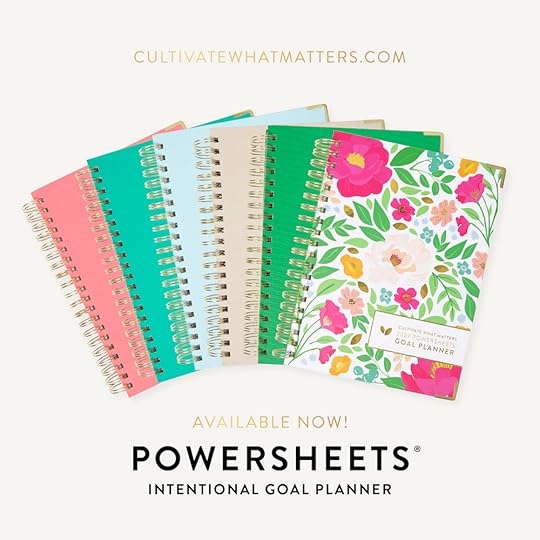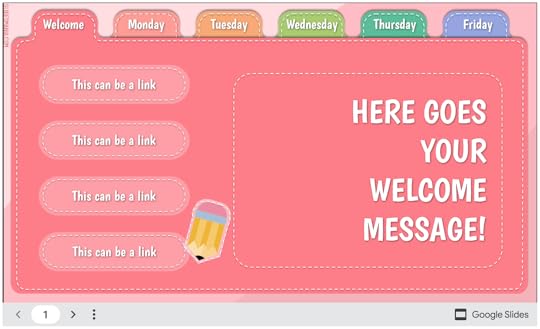Kasey Bell's Blog, page 25
January 25, 2022
Remote Learning Advice for Teachers – SULS0142
The post Remote Learning Advice for Teachers – SULS0142 appeared first on Shake Up Learning.
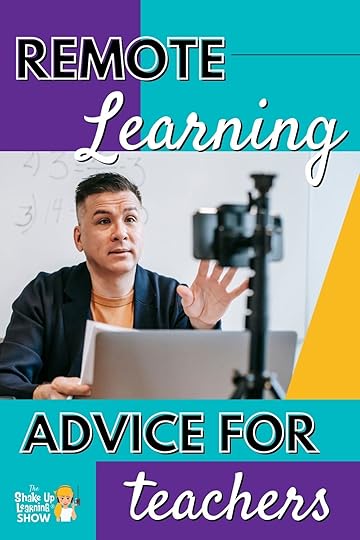 In this episode, Kasey chats with Shake Up Learning Team member Jen Giffen about remote learning.
In this episode, Kasey chats with Shake Up Learning Team member Jen Giffen about remote learning.
As many schools face staff shortages and need to go remote, let’s get some teaching advice to help make the most of remote learning.
Jen offers practical ideas and tips that will help you teach remotely!
Jen works as a teacher-librarian in Canada, just north of Toronto.
She’s been an educator for 21 years and has worn many hats, some of which include an EdTech specialist, an English teacher, and a high school librarian.
Remote Learning Advice for Teachers
Click To TweetListen to this article.
Remote Learning Advice for TeachersWhen the pandemic hit in mid-March Jen’s school went into asynchronous learning. At the time she was working as a teacher-librarian, her first year in this position, so navigating that online was tricky. The need for tech support was in high demand and that became her role.
In year two of the pandemic, Jen’s district shut down all of the libraries within the district and began a virtual school. This required more staff so Jen became an English teacher once again. This current school year is working as a hybrid model allowing Jen to be back in the library again supporting in any way possible. However, with the climb of illness, the government and district have been working on making school a safer place to be. To do this they went back into remote learning after the winter break. So Jen has experienced a lot of in and out of school throughout this pandemic situation.
amzn_assoc_tracking_id = "shauplea-20";amzn_assoc_ad_mode = "manual";amzn_assoc_ad_type = "smart";amzn_assoc_marketplace = "amazon";amzn_assoc_region = "US";amzn_assoc_design = "enhanced_links";amzn_assoc_asins = "1735601829";amzn_assoc_placement = "adunit";amzn_assoc_linkid = "45e28ed74bb20171862e30ab5be2b0c3";
In the first round of shutdowns and remote learning, many educators scrambled to make the best out of a completely new situation. Some Northern schools had started the use of virtual days rather than taking calamity days completely off. Now that so many teachers have the experience of teaching virtually many schools have kept this option for when severe weather strikes.
Having been through a round of virtual teaching many educators are now more equipped to understand what has worked and what will not work. They are much more familiar with the tools they can use and students are more experienced with the tools as well.
Making a quick shift with digital tools is easier for many teachers. It seems that many teachers have begun using more digital tools in their in-person instruction as well. Jen shares how she feels that teachers are utilizing digital tools in a way that now goes beyond substituting paper for computer.
Jen also shares how the digital divide has become more apparent. Understanding which students need more tech support allows teachers to make quick pivots because they now know which questions to ask students. Students have also become more proficient with the tech needed for remote learning.
amzn_assoc_tracking_id = "shauplea-20";amzn_assoc_ad_mode = "manual";amzn_assoc_ad_type = "smart";amzn_assoc_marketplace = "amazon";amzn_assoc_region = "US";amzn_assoc_design = "enhanced_links";amzn_assoc_asins = "1735601802";amzn_assoc_placement = "adunit";amzn_assoc_linkid = "4c02c8cc44526bc9fbb710edf527215a";
Jen took to Twitter to gather advice from colleagues and here’s what they all had to share.
1. Slow Down
During a period of remote learning, timing is going to take much longer. There are also likely situations where older siblings may need to babysit younger siblings. Or perhaps younger siblings are in need of help from an older sibling who isn’t available. Checking in with students to learn about their situation is important.
Slow things down, chunking more. – Zélia @ZeliaMCTEverything takes longer – especially as the day goes on. In HS my 1st class is fresh and ready. My last class is exhausted. – Stephanie Beatty @BeattycationAdjust your idea of what “normal” is and just go with their flow. – Stephanie Beatty @Beattycation2. Routines
Utilize your LMS for establishing a schedule for the week. Slides Mania is a great place to snag a free template for schedules. When it comes to creating an assignment schedule consider your learners. Chunking assignments that will take several days to complete can be helpful.
Communicate with students about how you’ve organized the LMS page for them. Jen shares an example where her students shared that they were only looking in the Google Classroom To-Do List rather than taking a look at the stream or classwork page. Helping students understand how to navigate the LMS.
Establish routines so students know what to expect – Heather Bamford @MsHBamfordShare slides or summaries to help students retain info – Sarah Wheatley @ksarahwhetleyamzn_assoc_tracking_id = "shauplea-20";amzn_assoc_ad_mode = "manual";amzn_assoc_ad_type = "smart";amzn_assoc_marketplace = "amazon";amzn_assoc_region = "US";amzn_assoc_design = "enhanced_links";amzn_assoc_asins = "1946444693";amzn_assoc_placement = "adunit";amzn_assoc_linkid = "3567fefd26ae685b347909c6cb09d453";
3. Making Connections
Allow students to chat with each other. Socializing for the younger students who may not own devices for doing this on their own time. Kids need a chance to talk with their classmates. Perhaps even add a time to meet on video with students for help or casual conversation.
Breakout rooms, small group connections, collaborating… it’s quiet. – Zélia @ZeliaMCTSchedule time to just connect with friends. – Zélia @ZeliaMCTA dedicated room to speak with the teacher> check-ins. – Zélia @ZeliaMCTTake advantage of being online. My littles are so happy to see each other’s faces sans mask. Share home things (pets, stuffies etc.), sing with abandon, share pics, build. – Christine Chin @MmeChinFSLUse what they tell you to engage/plan better. – Christine Chin @MmeChinFSLDesignate extra help time every week – Sarah Wheatley @ksarahwhetley4. Have Fun
Consider the ways that you can interact with students while teaching through video conference. Engage in ways that can be used in both the classroom and online.
Check-ins, games (sub-related or not). Wordle huge hit this week for my Eng students. – Stephanie Beatty @BeattycationIn this season, while teachers are continuing to move in and out of comfort zones and overwhelmed in so many ways, continue to support each other. Sharing what you’re learning through this season helps others. Continue to connect with other teachers on all the social media platforms and of course here on the podcast.
 About Jen Giffen
About Jen GiffenJen is a Teacher Librarian and EdTech Consultant. She has an M.Ed. from the University of Toronto and a specialist in Education Technology. Google Innovator, sketchnoter, podcaster, and dad joke aficionado, Jen seeks to ensure learning is authentic and relevant, especially for struggling students.
Current Certifications: Google Certified Educator Level 1, Google Certified Educator Level 2, Google Certified Trainer, Google Certified Innovator, Apple Teacher
Jen’s most popular presentations topics: Sketchnoting, Google tools, keynotes, and Flipgrid
© Shake Up Learning 2022. Unauthorized use and/or duplication of this material without express and written permission from this blog’s author and/or owner is strictly prohibited. Excerpts and links may be used, provided that full and clear credit is given to Kasey Bell and Shake Up Learning with appropriate and specific direction to the original content on ShakeUpLearning.com. See: Copyright Policy.
The post Remote Learning Advice for Teachers – SULS0142 appeared first on Shake Up Learning.
January 18, 2022
Google Search Easter Eggs for Your Classroom
The post Google Search Easter Eggs for Your Classroom appeared first on Shake Up Learning.
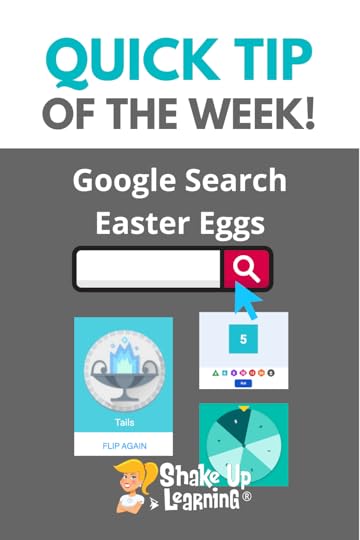
Did you know there are little tools and fun games hidden inside Google Search!
We call these “Easter Eggs!”
It has NOTHING to do with Easter, just something hidden that you discover, much like an Easter Egg hunt.
Try typing these in Google Search:
“google spinner”
“roll a die”
“flip a coin”
Google Search Easter Eggs for Your Classroom
Click To Tweet Google Search Easter Eggs for Your ClassroomRelated: How to Use Canva Templates in Google SlidesAccess ALL the Google Quick Tips Here!amzn_assoc_tracking_id = "shauplea-20";amzn_assoc_ad_mode = "manual";amzn_assoc_ad_type = "smart";amzn_assoc_marketplace = "amazon";amzn_assoc_region = "US";amzn_assoc_design = "enhanced_links";amzn_assoc_asins = "1735601829";amzn_assoc_placement = "adunit";amzn_assoc_linkid = "45e28ed74bb20171862e30ab5be2b0c3";
amzn_assoc_tracking_id = "shauplea-20";amzn_assoc_ad_mode = "manual";amzn_assoc_ad_type = "smart";amzn_assoc_marketplace = "amazon";amzn_assoc_region = "US";amzn_assoc_design = "enhanced_links";amzn_assoc_asins = "1735601802";amzn_assoc_placement = "adunit";amzn_assoc_linkid = "4c02c8cc44526bc9fbb710edf527215a";
© Shake Up Learning 2022. Unauthorized use and/or duplication of this material without express and written permission from this blog’s author and/or owner is strictly prohibited. Excerpts and links may be used, provided that full and clear credit is given to Kasey Bell and Shake Up Learning with appropriate and specific direction to the original content on ShakeUpLearning.com. See: Copyright Policy.
The post Google Search Easter Eggs for Your Classroom appeared first on Shake Up Learning.
Must-Have Tips and Tools for Pandemic Teaching – SULS0141
The post Must-Have Tips and Tools for Pandemic Teaching – SULS0141 appeared first on Shake Up Learning.
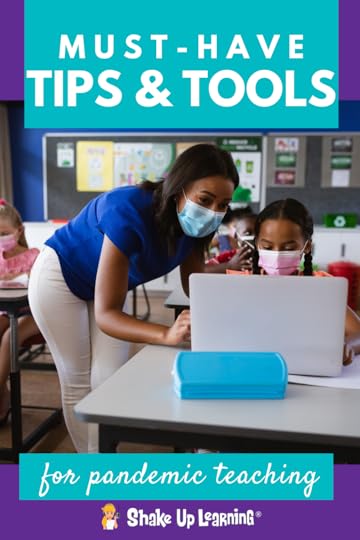 In this episode, Kasey shares her best Pandemic Teaching tips and tools. Everything you need to survive this school year and thrive beyond. Learn practice strategies, organization techniques, and a whole list of tools to make teaching this year EASIER!
In this episode, Kasey shares her best Pandemic Teaching tips and tools. Everything you need to survive this school year and thrive beyond. Learn practice strategies, organization techniques, and a whole list of tools to make teaching this year EASIER!
While these tips and tools are extremely helpful in this pandemic environment of teaching, they are also helpful for any blended learning classroom.
Virtual learning is here to stay! This is why digital equity is so important.
Teaching students to be good citizens in a digital world has become a vital part of education.
Must-Have Tips and Tools for Pandemic Teaching – SULS0141
Click To TweetListen to this article.
Must-Have Tips and Tools for Pandemic TeachingBefore we jump into the tips and tools, let’s talk about the topics that have come to the forefront during the pandemic.
These topics & skills that have become MORE important than ever:
Digital EquityDigital Skills for teachers and studentsDigital ToolsOffline vs. Online learningStreamlining Communication among all stakeholdersPrivacy & SafetyDigital CitizenshipGrades ≠ LearningPandemic Teaching TipsRemember Your WhyThe negative attitude and animosity towards educators in this pandemic have been extremely disheartening. Much of this is causing a mass exodus of teachers. As many teachers are leaving the profession, and even more are debating if this is all worth it, I want you to take time to reflect. Reflect on the good, the bad, and the ugly. Get back to your why!
Why did you become a teacher? What does being a teacher mean to you? Once you have these answered use them to motivate your goals.
Goal SettingA great way to refresh and start the new year is to do some goal setting. Using your reflection to see what you accomplished last year, brainstorm ideas and goals for the new year. Think of professional and personal goals. Do these align with your “Why”?
Kasey recommends using Lara Casey’s Power Sheets for the last several years to reflect and goal set each year and revise each month. (Related: How to Work from Home and Get Things Done.)
2022 PowerSheets® CollectionGet and Stay OrganizedTaking inventory of your organization’s systems can also help us to feel less overwhelmed. A strong organizational system allows you to shift quickly. Consider sharing weekly plans with students and parents. This seemed to work better in remote learning rather than sharing only daily assignments.
How to share these assignments is another factor when thinking about organization. A great place for templates that can make sharing assignments easy is the Slides Mania website. Creating Slides to share assignments and details with students can allow for a smooth asynchronous learning experience.
Embrace Asynchronous LearningKasey has shared many options and ideas for making this type of learning successful for any teacher. Whether it be using her choice board template ideas or producing videos for learning. Students are able to work at their own pace in this environment. It can also provide teachers with more flexibility whether in or out of the classroom.
Related: Synchronous vs. Asynchronous Online Learning
Related: Asynchronous Learning Tips for Teachers
Embrace Audio LearningUtilizing many modes for learning is always a best practice for supporting learners. Some of these would include audio, text, images, or video. Offering as many as possible can help support all types of learners.
The Opportunity for Dynamic LearningThis is the concept of dynamic learning. Each of Kasey’s books, Shake Up Learning, and Blended Learning with Google, share details about the pedagogical ideas of dynamic learning, along with example lesson plans. There are also several FREE resources that can provide educators with the tools they need to incorporate dynamic learning into their lessons. amzn_assoc_tracking_id = "shauplea-20";amzn_assoc_ad_mode = "manual";amzn_assoc_ad_type = "smart";amzn_assoc_marketplace = "amazon";amzn_assoc_region = "US";amzn_assoc_design = "enhanced_links";amzn_assoc_asins = "1735601829";amzn_assoc_placement = "adunit";amzn_assoc_linkid = "45e28ed74bb20171862e30ab5be2b0c3";
If audio learning is your jam try this 3-part podcast series on Blended Learning with Google. Perhaps you’d prefer text, then this Blended Learning with Google Toolkit would be more your style.
Offline vs Online LearningIn this world of remote or distance learning, there is still a place for offline assignments and learning. This is especially vital when teachers discover how wide the digital learning gap might be for their students. Which is one more reason to consider how grading is established during this time. It’s important that grades truly reflect the learning that is taking place. It can be difficult when teachers are living in survival mode most of the time. Incorporating a blended learning environment can help students and teachers feel more comfortable when the need arises for distance learning.
Related: Blended Learning Best Practices with Caitlin Tucker
Sharpen Your SawAnother great way to sharpen your saw, so to speak, and gain back some motivation for this school year is to join other like-minded educators with an online book study facilitated by Kasey.
FREE! Join the Blended Learning with Google Book Study (3 Credit Hours!)
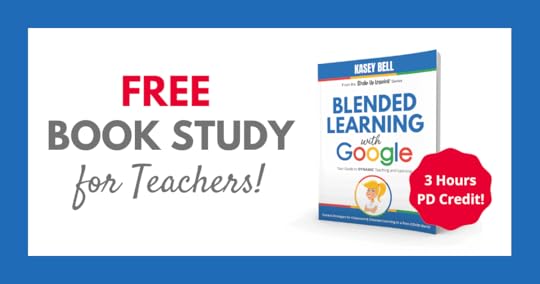
Participating in this professional development not only allows you to engage with other educators and Kasey, but you can also earn 3 credit hours! Learning from the book is only half of what this study can offer. The real magic happens through conversation with other like-minded teachers.
Must-Have Tools for Pandemic TeachingIt’s not about Google or the Tech, it’s about the learnings–just like it has always been. The tools and tech can be helpful for student learning, especially in this current pandemic environment. Choosing the right tool is an important factor, so knowing the options helps teachers make an educated decision.
Google Workspace for EducationGoogle is a great place to start since many schools are utilizing Google Classroom for a Learning Management System. Other LMS options like Canvas and Schoology can also utilize the entire G Suite of tools.
Pear DeckAside from the Google options, there are add-ons like Pear Deck. This is a great tool for formative assessments. Peardeck provides student-paced options that can work well with remote learning. This tool provides several templates that make it simple to create.
Related: 15 Collaborative Tools for Your Classroom that are NOT Google
NearpodAnother great tool is Nearpod. Although it may not be free, many schools have purchased this tool for their teachers to use while teaching remotely. It’s truly a powerful tool with its interactive capabilities. Teachers can take previously created slides or videos and incorporate them into a Nearpod lesson to add interactive elements.
Lumio by SMARTHave you discovered Lumio? This tool was developed by SMART and Kasey recently participated in a demo to learn more. Lumio combines all of your teaching resources no matter the format and allows you to gamify lessons or assessments. Teachers can also easily switch between student-paced and teacher-paced lessons. A real powerhouse tool for educators!
FlipgridEvery educator should be using Flipgrid! This video response tool has become a robust tool for learning in the pandemic and beyond. Do not be intimidated by the video option. There are many ways for students and teachers to share without needing to be on camera. Learn more about how this amazing tool can be used in your classroom by listening to episode 80.
Related: Flipgrid: The Go-To Remote Learning Tool!
ScreencastifyA great tool for recording your computer screen is Screencastify. This Chrome extension has a free and paid version. The free option does provide much of what you will need to record and upload for any lesson. Students can also utilize this tool to share or explain learning.
Video Conferencing Tools Like Zoom or Google MeetThe two most popular video conferencing tools are Zoom and Google Meet. While asynchronous learning is the focus, there is also a place for synchronous opportunities to learn as well.
Tutorial Creation Tools Like Loom or IoradGoing back to the idea of recording the computer screen can be an important part of remote learning. Whether it be showing students or parents where to click and where to go for specific tasks, Loom can help with tutorial creation.
A tool that was created specifically for the purpose of creating these screen tutorials and highly recommended by Jen Giffin, is Iorad. This tool is not free, but Jen is a big fan so it must be great!
Slides ManiaTemplates can make a teacher’s life so much easier! Slides Mania is an amazing treasure box filled with templates for educators. Many were created by educators!
MoteWhen using audio within lessons or for feedback, Mote is the perfect tool. In episode 107, Kasey shared 15 ways to use Mote in your classroom. For a quick tutorial on how to use Mote, take a look at this Quick Tip video.
Web PaintWeb paint is one she loves for capturing annotations to the screen which can then be shared with students.
Custom CursorCustom cursor is a favorite for not just changing the shape, but also the size. This allows for students to see better when viewing on smaller screens.
Tab MuterA helpful extension to silence the videos on websites is called Tab Mute. With a simple click, all videos playing can be muted at once.
Voice Typing (Speech-to-Text)Voice typing is a great way to save time! This is available in many different apps, including Google Docs!
The Great SuspenderToo many open tabs? Use the Great Suspender to suspend tabs you aren’t using without closing them and save RAM. This will help your computer run faster!
Extra MonitorThe luxury of a double monitor set-up cannot be undersold! This is highly recommended by Susan Vincentz on the Shake Up Learning Team. The extra real estate will help you see more windows at once.
JamboardFor an interactive space online, Susan recommends using Jamboard. This is a giant digital whiteboard!
Try Padlet or WakeletOther great collaborative tools include Padlet and Wakelet. Think of these as digital bulletin boards where digital information can be collected and organized.
EdpuzzleFinally, a tool that can be incredibly useful for assessments is EdPuzzle. This fantastic tool allows you to make video lessons, yours and others, interactive. Students can answer questions, take notes, or write a response before moving on in the video.
These tools merely skim the surface of what’s possible in the digital world of education. Learn more by exploring the Shake Up Learning blog and stay tuned for more episodes of the podcast.
Check out: 50 Remote Learning Resources for Teachers and Schools
© Shake Up Learning 2022. Unauthorized use and/or duplication of this material without express and written permission from this blog’s author and/or owner is strictly prohibited. Excerpts and links may be used, provided that full and clear credit is given to Kasey Bell and Shake Up Learning with appropriate and specific direction to the original content on ShakeUpLearning.com. See: Copyright Policy.
The post Must-Have Tips and Tools for Pandemic Teaching – SULS0141 appeared first on Shake Up Learning.
January 11, 2022
How to Duplicate a Page in Google Sites
The post How to Duplicate a Page in Google Sites appeared first on Shake Up Learning.
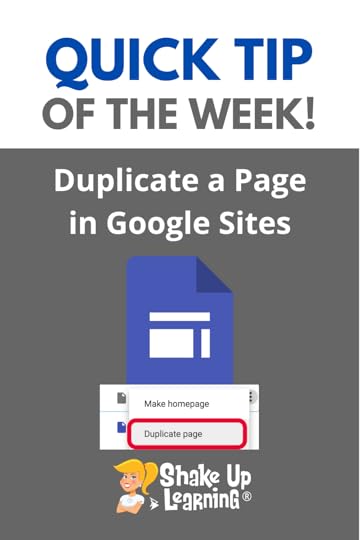 Need to create pages with a similar layout in Google Sites?
Need to create pages with a similar layout in Google Sites?
Save time and duplicate a page in Google Sites!
There are many times that I need to duplicate a page.
When you or your students are creating a Google Site, you may wish to create pages with similar layouts and design.
You can save time by duplicating pages and making tweaks instead of starting over from scratch.
How to Duplicate a Page in Google Sites
Click To Tweet How to Duplicate a Page in Google SitesRelated: How to Use Canva Templates in Google SlidesAccess ALL the Google Quick Tips Here!amzn_assoc_tracking_id = "shauplea-20";amzn_assoc_ad_mode = "manual";amzn_assoc_ad_type = "smart";amzn_assoc_marketplace = "amazon";amzn_assoc_region = "US";amzn_assoc_design = "enhanced_links";amzn_assoc_asins = "1735601829";amzn_assoc_placement = "adunit";amzn_assoc_linkid = "45e28ed74bb20171862e30ab5be2b0c3";
amzn_assoc_tracking_id = "shauplea-20";amzn_assoc_ad_mode = "manual";amzn_assoc_ad_type = "smart";amzn_assoc_marketplace = "amazon";amzn_assoc_region = "US";amzn_assoc_design = "enhanced_links";amzn_assoc_asins = "1735601802";amzn_assoc_placement = "adunit";amzn_assoc_linkid = "4c02c8cc44526bc9fbb710edf527215a";
© Shake Up Learning 2022. Unauthorized use and/or duplication of this material without express and written permission from this blog’s author and/or owner is strictly prohibited. Excerpts and links may be used, provided that full and clear credit is given to Kasey Bell and Shake Up Learning with appropriate and specific direction to the original content on ShakeUpLearning.com. See: Copyright Policy.
The post How to Duplicate a Page in Google Sites appeared first on Shake Up Learning.
10 Things for Teachers to Try in 2022 – SULS0140
The post 10 Things for Teachers to Try in 2022 – SULS0140 appeared first on Shake Up Learning.
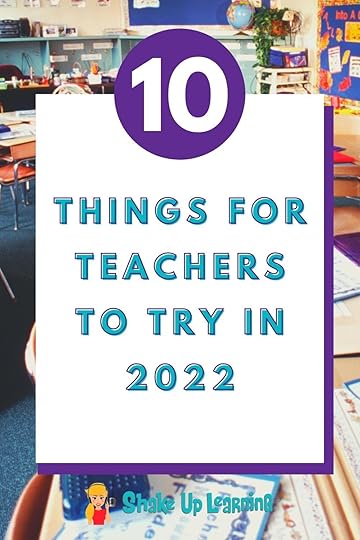 Let’s kick off the new year with some great teaching ideas!
Let’s kick off the new year with some great teaching ideas!
In this episode, Kasey shares 10 Things for Teachers to Try in 2022.
We will explore strategies, digital tools, professional learning, and much more! What will you try in 2022?
Chances are you’ve been roaming out of your comfort zone for the past two years and have been trying a lot of new things.
But it’s that time of year, a time to renew and refresh. So here are ten things that you may want to try.
No matter the subject or grade level, you’re bound to find a great idea just for you.
10 Things for Teachers to Try in 2022
Click To TweetListen to this article.
Let’s Talk About 5 Shifts We Need in Education Now!Join me, Kasey Bell, on the Wisdom app to discuss changes that need to happen in education now.
Download the Wisdom appFollow @ShakeUpLearning (you’ll get notified when the talk is live)Join me live on Jan. 14 at 10 AM CST (or listen later)1. Storytelling with Google ToolsThe concept of storytelling is not just for the Reading and Writing teachers. Telling a story can look like a lot of different things. For example, retelling events in your own words, changing perspectives, inventing new stories, sharing steps in a process, and so many more. Take a listen to episode 89 of the Shake Up Learning Podcast for many more ideas on storytelling.
Ebooks are a great way to have students create any of those storytelling ideas. Mike Mohammad shared how he used Google Slides for his physics students to explain concepts to younger kids.
Stop motion animation in Google Slides can be a little more complicated, but also a really fun way for students to show through images.
Comic strips and interactive timelines are two forms of storytelling that can easily be created with Slides or even in Drawings. Both of these help to bring life to sharing the order of events.
Another fun way to tell stories through geography is with Google Earth. It allows you to create a tour with the addition of comments, notes, and images.
2. Collaborative NotesNote-taking is a difficult concept for students to grasp. Often times they either write down everything or only what gets written on the board. Pulling out the most important information doesn’t always happen when students take notes. Allowing them to be in a collaborative setting can guarantee that they will get the most important information. In this blog post, Kasey walks you through the steps of training students to take collaborative notes through Docs.
Collaborative notes are also a great way to keep track of important information from staff meetings or any professional development.
amzn_assoc_tracking_id = "shauplea-20";amzn_assoc_ad_mode = "manual";amzn_assoc_ad_type = "smart";amzn_assoc_marketplace = "amazon";amzn_assoc_region = "US";amzn_assoc_design = "enhanced_links";amzn_assoc_asins = "1946444693";amzn_assoc_placement = "adunit";amzn_assoc_linkid = "3567fefd26ae685b347909c6cb09d453";
There are many ways for students to share work with an authentic audience. Consider the power of an audience for students. Quality of work generally levels up when students know someone other than their teachers are going to see it. Students of today are accustomed to sharing with an audience so why should their learning be any different?
Teaching them safe ways for sharing over the internet is a lesson in and of itself. These lessons for responsible sharing are likely to influence their personal sharing as well. Having an authentic audience doesn’t always mean sharing with the world. Start small with another classroom and grow into a wider audience.
4. SEL Check-in with Google FormsSocial-Emotional Learning had begun to surface in the classroom before the pandemic hit, however, in light of the pandemic it has become much more important. Using a Google Form, to check in with students can be a foundational relationship builder. The Form allows students to share privately, even if it’s as simple as an emoji to share how they are feeling.
5. Podcasting with StudentsThe way that people connect with hearing another person’s voice is incredibly powerful. Podcasting provides a way for students to share their learning, but to also gain learning. Jen Conti recently shared how podcasting can help educators to meet standards while giving students a creative product. To learn all about how to engage students through podcasting take a listen to episode 130. Utilizing podcasts for blended learning can really help students express themselves creatively.
amzn_assoc_tracking_id = "shauplea-20";amzn_assoc_ad_mode = "manual";amzn_assoc_ad_type = "smart";amzn_assoc_marketplace = "amazon";amzn_assoc_region = "US";amzn_assoc_design = "enhanced_links";amzn_assoc_asins = "1735601802";amzn_assoc_placement = "adunit";amzn_assoc_linkid = "4c02c8cc44526bc9fbb710edf527215a";
Discover a mountain of templates that can be created and personalized in a free online tool. Start with this two-part series, episodes 132 and 133, for ideas and the possibilities that Canva provides to teachers and students. From adding beautiful graphics as a Google Classroom header to creating a professional-looking website, Canva provides you with the template you’re looking for.
7. Fake It ‘til You Make ItSocial media has the attention of our students. Mimicking this medium for storytelling engages our students in a platform that is familiar to them. In episode 32 Kasey talked with Lisa Johnson about a fake Instagram template she created in Keynote. That episode inspired Carly Black to create a similar template using Google Slides that she used in her own Language Arts classroom.
Lisa also shared a creative way to fake blog with students using a template she created. Her template shares some interesting ways for students to express creativity and incorporate many aspects of their learning.
8. Podcast PDLearning through podcasts continues to grow as a preferred method for many people. If there is something you’d like to learn about chances are you could find a podcast that could teach you. Each of the Shake Up Learning podcast episodes is uploaded into a course on the Teachable platform in the All-Access Pass class. Within this course, a certificate can be printed for listening and learning then presented to an administrator for credit of professional development.
The Shake Up Learning podcast continues to be free and expects to break 1 million downloads early in 2022. If you are interested in learning more about the all-access pass take a look at the online school for a list of courses and Master Classes.
Back in episode 138, Kasey shared what she learned from taking the new Google Certification exams. Turns out the questions have all been changed to multiple-choice or drag and drop, making the test much easier.
Google Certification can be a major game-changer for educators. So much can be learned through the process of becoming certified, but also the connections and confidence gained are extremely helpful. To learn more about the entire process check out the free webinar and specific courses for walking you through each exam and even working towards a Google Certified Trainer.
amzn_assoc_tracking_id = "shauplea-20";amzn_assoc_ad_mode = "manual";amzn_assoc_ad_type = "smart";amzn_assoc_marketplace = "amazon";amzn_assoc_region = "US";amzn_assoc_design = "enhanced_links";amzn_assoc_asins = "1735601829";amzn_assoc_placement = "adunit";amzn_assoc_linkid = "45e28ed74bb20171862e30ab5be2b0c3";
Join our next online book study in March! Perhaps you haven’t had time to read the book just yet or you’re ready to read it again. An online book study is a great way to engage with other educators and learn so many great ideas to help transform your classroom. Learn more about the book study here. Be sure to grab your seat as soon as possible!
© Shake Up Learning 2022. Unauthorized use and/or duplication of this material without express and written permission from this blog’s author and/or owner is strictly prohibited. Excerpts and links may be used, provided that full and clear credit is given to Kasey Bell and Shake Up Learning with appropriate and specific direction to the original content on ShakeUpLearning.com. See: Copyright Policy.
The post 10 Things for Teachers to Try in 2022 – SULS0140 appeared first on Shake Up Learning.
January 10, 2022
50 Remote Learning Resources for Teachers and Schools
The post 50 Remote Learning Resources for Teachers and Schools appeared first on Shake Up Learning.
Here are the best remote learning resources for teachers and schools from Shake Up Learning–all on one page!
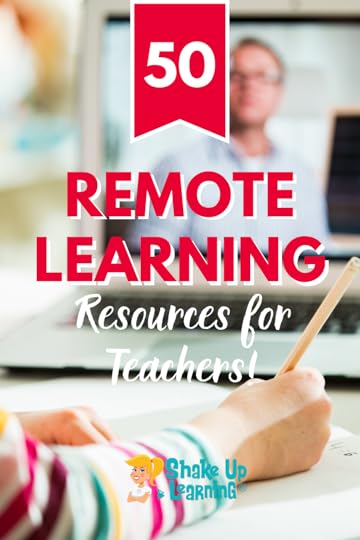 Remote learning is tough! We all need as much support as we can get right now.
Remote learning is tough! We all need as much support as we can get right now.
In this post, you will find cheat sheets, templates, tips, blog posts, podcasts, tutorials, online courses, and more to help you rock remote learning!
These are resources and skills that will help you no matter where you find yourself teaching, at home remotely, at school, or somewhere in between.
I hope these tips and resources will help you maximize your time with students and engage them in new ways.
50 Remote Learning Resources for Teachers and Schools
Click To Tweet 50 Remote Learning Resources for Teachers and SchoolsGoogle Classroom1. Google Classroom Cheat Sheets for Teachers and Students
2. The Google Classroom Master Class
3. 10 Google Classroom Tips for Remote Learning
4. Google Classroom FAQ – Your Most Common Questions ANSWERED!
5. How to Integrate Google Classroom with Google Meet
6. 50 Google Classroom Resources That Will Make Your Day
7. 5 Chrome Extensions that Make Google Classroom Even More Awesome!
8. 85+ Awesome Apps that Integrate with Google Classroom
9. How to Use Google Templates and Assign in Google Classroom
10. How to Package Your Digital Assignments
11. How to Organize Assignments in Google Classroom
12. Google Classroom Quick Tip Video Playlist
General Remote Teaching and Learning13. Teaching Digitally Resource Guide (FREE)
14. Asynchronous Learning Tips for Teachers
15. Blended Learning Best Practices (with Catlin Tucker)
16. Synchronous vs. Asynchronous Online Learning
17. Back to School Online Learning Activities
18. 10 Google Tips for Remote Learning
19. Shake Up Learning: Practical Ideas to Move Learning From Static to Dynamic (book)
20. Blended Learning with Google: Your Guide to Dynamic Teaching and Learning (book) – AND FREE Book Study
21. 12 Practical Tips for Remote Learning
22. Home Learning Strategies for Primary Students that ALL Teachers Can Use!
23. How to Work From Home and Get Things Done!
24. Lessons Learned From Remote Learning
25. What Students Have to Say About Remote Learning [interviews with a 3rd and 12th grader]
26. Online Teaching Best Practices, Tips, and Tools
27. Flipgrid: The Go-To Remote Learning Tool
28. The Dynamic Learning Workshop
29. The Blended Learning with Google Workshop
amzn_assoc_tracking_id = "shauplea-20";amzn_assoc_ad_mode = "manual";amzn_assoc_ad_type = "smart";amzn_assoc_marketplace = "amazon";amzn_assoc_region = "US";amzn_assoc_design = "enhanced_links";amzn_assoc_asins = "1946444693";amzn_assoc_placement = "adunit";amzn_assoc_linkid = "3567fefd26ae685b347909c6cb09d453";
30. Back to School with Choice Boards (FREE Templates)
31. Home Learning with Choice Boards
32. FREE Interactive Tic-Tac-Toe Choice Board for Google Slides
33. Interactive Learning Menus (Choice Boards) with G Suite
34. FREE Google Templates for Teachers from Shake Up Learning
35. Fake Instagram Template with Google Slides (FREE)
Leadership Resources36. Leading Through Crisis and Beyond for Teachers and Educational Leaders
38. The Future of Online Teaching
39. Google Training for Schools
Video Meeting Resources40. 10 Things You Didn’t Know About Google Meet
41. 10 Things You Didn’t Know About Zoom
More Google Resources42. 10 Ways Google Certification Can Support Remote Learning
43. The Chromebook Infused Classroom
44. Google Quick Tips Video Library for Teachers
45. 10 Google Docs Tips Every Teacher Should Know
46. 13 Tools to Record Audio on Chromebooks and Other Devices
47. 13 Tips to Organize Your Google Drive
48. The Google Slides Master Class
49. The Google Certified Educator Level 1 Academy
50. Google Quick Tips Video Playlist
Check out ALL our Remote and Blended Resources Here!
© Shake Up Learning 2022. Unauthorized use and/or duplication of this material without express and written permission from this blog’s author and/or owner is strictly prohibited. Excerpts and links may be used, provided that full and clear credit is given to Kasey Bell and Shake Up Learning with appropriate and specific direction to the original content on ShakeUpLearning.com. See: Copyright Policy.
The post 50 Remote Learning Resources for Teachers and Schools appeared first on Shake Up Learning.
January 4, 2022
View ONE Slide at a Time in Google Slides (Hide Filmstrip View)
The post View ONE Slide at a Time in Google Slides (Hide Filmstrip View) appeared first on Shake Up Learning.
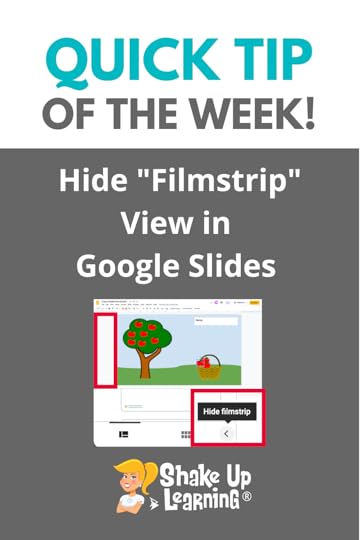 When using Google Slides for creation and activities like drag-and-drop with your students, it can be difficult to get the right view.
When using Google Slides for creation and activities like drag-and-drop with your students, it can be difficult to get the right view.
Try hiding the “Filmstrip” to view one slide at a time in edit mode.
You can use the arrow at the bottom of the filmstrip or go to view > hide filmstrip.

View ONE Slide at a Time in Google Slides (Hide Filmstrip View)
Click To Tweet View ONE Slide at a Time in Google Slides (Hide Filmstrip View)Related: How to Use Canva Templates in Google SlidesAccess ALL the Google Quick Tips Here!amzn_assoc_tracking_id = "shauplea-20";amzn_assoc_ad_mode = "manual";amzn_assoc_ad_type = "smart";amzn_assoc_marketplace = "amazon";amzn_assoc_region = "US";amzn_assoc_design = "enhanced_links";amzn_assoc_asins = "1735601829";amzn_assoc_placement = "adunit";amzn_assoc_linkid = "45e28ed74bb20171862e30ab5be2b0c3";
amzn_assoc_tracking_id = "shauplea-20";amzn_assoc_ad_mode = "manual";amzn_assoc_ad_type = "smart";amzn_assoc_marketplace = "amazon";amzn_assoc_region = "US";amzn_assoc_design = "enhanced_links";amzn_assoc_asins = "1735601802";amzn_assoc_placement = "adunit";amzn_assoc_linkid = "4c02c8cc44526bc9fbb710edf527215a";
© Shake Up Learning 2022. Unauthorized use and/or duplication of this material without express and written permission from this blog’s author and/or owner is strictly prohibited. Excerpts and links may be used, provided that full and clear credit is given to Kasey Bell and Shake Up Learning with appropriate and specific direction to the original content on ShakeUpLearning.com. See: Copyright Policy.
The post View ONE Slide at a Time in Google Slides (Hide Filmstrip View) appeared first on Shake Up Learning.
Chrome Squad: Student Tech Teams to Support 1-1 Schools – SULS0139
The post Chrome Squad: Student Tech Teams to Support 1-1 Schools – SULS0139 appeared first on Shake Up Learning.
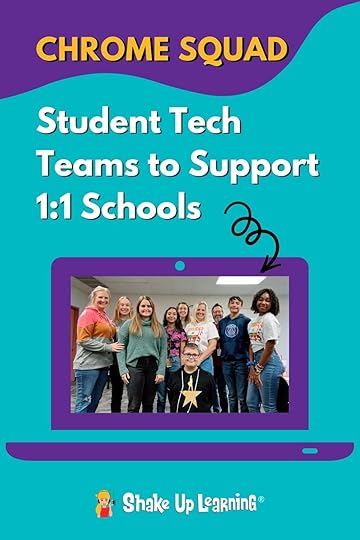
Supporting a 1-to-1 environment is a daunting task! Empower your students through student tech teams. In this interview with the Royse City ISD High School and Middle School student tech teams (a.k.a. Chrome Squad) and their leaders, we explore the success of their program. We talk about how the program has evolved, what they are doing next, and how to implement your own program at the high school, middle school, or even elementary!
Cody Holt, Coordinator of Learning Technologies, is a new title for him as he oversees the Chrome Squad and all other integrated technologies. Heather Russell, Innovative Learning Specialist runs the Chrome Crew for Bailey Middle School. Kendal Whisnant, Innovative Learning Specialist leads the charge of the Chrome Co for Summers Middle School. Angela Arledge, Innovative Learning Specialist heads the Royse City high school’s Chrome Squad.
Chrome Squad OriginsCody first developed the idea for a Chrome Squad during the 2015-2016 school year. The district made plans for the high school to transition to 1:1 Chromebooks. Originally, the plan included two other adults to help Cody make this happen, however, those two positions were not hired. Cody was given permission to incorporate students through an elective course, so he went to work researching how to make this happen.
His intention was to run a very well-developed and organized system. Similar to corporations like Google, Apple, and Microsoft. After studying how these companies organized their employees he “hired” student (unpaid) interns. Some of the tasks they would complete include: manage Chromebook check-in and out, necessary repairs, student enrollment, teacher professional development, student help desk, and much more.
Initially, eligible students came from the sophomore, junior and senior classes. Now students in middle and high school are participating. Heather Russell was asked to oversee the integration of 1:1 at Bailey Middle School, and like Cody, she was alone in getting all the tech up and running for students. So out of necessity, she recruited students to help her with repairs and then developed specific teams for other areas. As the group of students grew the teams created cover tasks for training, technical tasks, and even public relations. These teams mirror what’s available and done at the high school.
Anglea shares how their middle school interns have become a feeder program for the high school’s Chrome Squad. This allows for higher quality interns and less time teaching students necessary tasks. The student’s background knowledge allows the program to continue to grow and evolve.
Students shared what their role includes as a member of the different teams. The technicians are of course helping students and teachers with issues of a physical nature. They work through basic troubleshooting tasks to help or make necessary replacements. The public relations team is charged with advertising through posters and television slide presentations.
The podcast team works to record episodes for students and teachers with tech tips and basic tech knowledge. This team was created out of the need to share from a distance during the pandemic. Students on this team typically record a short 90-second audio training to help teachers and students make a quick transition to remote learning techniques. A number of their episodes are geared specifically for teachers. All episodes of the Connected for Learning podcast can be found on Apple or Spotify. They also share content on their Connected for Learning website.
Back to the ClassroomStudent interns shared that being back in person has been going very well for the staff and students. Teachers are utilizing more Google applications and extensions, as well as, the built-in features of the Chromebook. Teachers are also encouraged to learn new skills through a badge system which is rewarded with prizes. Students on the Chrome Crew and Chrome Co publish a single sheet of tech tips for teachers and students in what they call the “Porcelain Post” taped to the bathroom stall doors.
Making GrowthThe staff leaders of these student teams consistently evaluate what’s working and what’s not working. When they discover what’s not working they eliminate that practice and move on to support the efforts that are having success. Sometimes it means combining teams to work together in their expertise.
In order to effectively evaluate, student teams work to set goals for the three-week grading period and reflect on the success of these goals being met. Setting the goals for what to accomplish in the three-week period is a collaborative effort with students and staff leaders. With restrictions of the pandemic in place, many hurdles have needed to be overcome, making the collaborative process necessary.
Real-World ExperiencesOne of the charges given to the Chrome Squads is managing a school store. This is a place where students and staff can purchase snacks or basic school supplies. Team members are charged with keeping track of inventory and sales, serving customers, and working a register. The proceeds go toward helping support the Connected for Learning website and other needs for the teams.
In the FutureStudent participants are expanding to younger grades at the middle school in order to keep a healthy feeder program running. Working to help buildings with the online testing has given Chrome teams the challenge of preparing students for being ready. Simple tasks like coming with a fully charged Chromebook have the team collaborating on rewards and consequences for being responsible with their Chromebooks. These types of irresponsible issues are typically a middle school issue and the Chrome Crew helps to incentivize and reinforce responsible Chromebook users. The structure of the Chromebook system allows students to purchase their Chromebook as graduating seniors. This system also helps students to keep their Chromebook in good working order.
Royse City will be moving its elementary school to 1:1 in the upcoming school year. They plan to start teams of third and fourth graders to initiate an elementary squad.
Staff leaders and students will attend and present at this year’s TCEA conference. Their presentations will include a poster session with members of each team to explain their roles.
To wrap up, students shared that they have enjoyed learning new skills. Some highlighted the people skills they have gained through relationships with students as they help serve them. They also expressed how the tech skills they’ve learned have given them career ideas and creative outlets.
Cody shares that he and his student groups are available to help other school districts start their own program. Whether it be a teacher presentation or student presentation, they are willing to provide any support.
© Shake Up Learning 2022. Unauthorized use and/or duplication of this material without express and written permission from this blog’s author and/or owner is strictly prohibited. Excerpts and links may be used, provided that full and clear credit is given to Kasey Bell and Shake Up Learning with appropriate and specific direction to the original content on ShakeUpLearning.com. See: Copyright Policy.
The post Chrome Squad: Student Tech Teams to Support 1-1 Schools – SULS0139 appeared first on Shake Up Learning.
December 14, 2021
The Best Teacher Tips and Lesson Ideas of 2021
The post The Best Teacher Tips and Lesson Ideas of 2021 appeared first on Shake Up Learning.
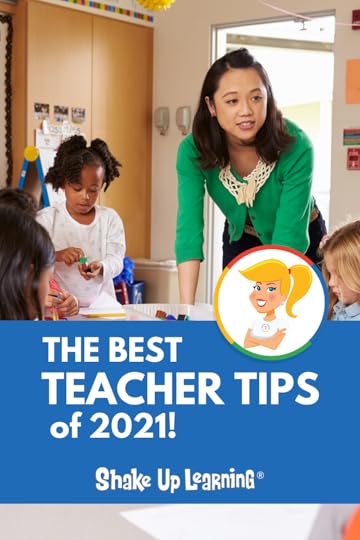 Here are the BEST Blog Posts and Podcasts of 2021!
Here are the BEST Blog Posts and Podcasts of 2021!
I have put together a list of the BEST and most popular Shake Up Learning blog posts and podcast episodes from 2021.
These posts are loaded with the BEST teacher tips and lesson ideas of the year.
A special thank you to all the Shake Up Learning readers and listeners. Y’all rock!
And thank you for dawning your superhero capes to carry our students through ANOTHER tumultuous year!
Let’s take some time to reflect on the positive and make 2022 the best year yet!
Reflection is a critical part of the learning process for teachers and students, so I like to take a look back.
I like to take a more in-depth look at what teacher tips, blog posts, and podcast episodes were the most popular and generated the most comments and traffic.
The goal of this blog has always been to provide teachers with digital learning resources, tips, and tricks, and help teachers find ways to integrate technology meaningfully in the classroom.
This list helps me decide what content to create and how to best help teachers in 2022.
The Best Teacher Tips and Lesson Ideas of 2021
Click To Tweet What Do YOU Want to See in 2022?I want to serve my audience! Help me better serve you by completing this short, 60-second survey. (The form is also embedded at the bottom of this post.)
This survey is your chance to let me know more about you and what you need in 2022.
The Top 20 Posts of 2021Drumroll please…Here are the most popular blog posts and podcast episodes of the year!
1. 27 Formative Assessment Tools for Your ClassroomIn this post and podcast episode, you will find 27 Formative Assessment Tools for Your Classroom! This list has a wide variety of features and options to help you solidify your formative assessment strategies! Many of the tools below are great for both formative and summative assessments.
amzn_assoc_tracking_id = "shauplea-20";amzn_assoc_ad_mode = "manual";amzn_assoc_ad_type = "smart";amzn_assoc_marketplace = "amazon";amzn_assoc_region = "US";amzn_assoc_design = "enhanced_links";amzn_assoc_asins = "1735601829";amzn_assoc_placement = "adunit";amzn_assoc_linkid = "45e28ed74bb20171862e30ab5be2b0c3";
This is a post that I update every year, and it is always at the top of the list! Learn about 85+ applications that integrate with Google Classroom.
Fill Out the Form Below to Get Your FREE Cheat Sheets!3. How to Create a Google Classroom Custom Header with Google DrawingsIn this post and video tutorial, I will show you how to create a custom header with Google Drawings, give you a FREE template, and show you how to upload it into Google Classroom!
4. Digital Badges in the Classroom (What, When, & How)Digital badges can help us engage students (even remote learners). Learn what digital badges are, when to use them, and how to implement them in your classroom.
5. 15 Collaborative Tools for Your Classroom That Are NOT GoogleThis post and podcast episode includes 15 collaborative tools for your classroom that are NOT Google. Collaboration is a critical twenty-first-century skill for our students. Finding ways to facilitate and support collaboration in the classroom is not always easy.
amzn_assoc_tracking_id = "shauplea-20";amzn_assoc_ad_mode = "manual";amzn_assoc_ad_type = "smart";amzn_assoc_marketplace = "amazon";amzn_assoc_region = "US";amzn_assoc_design = "enhanced_links";amzn_assoc_asins = "1735601802";amzn_assoc_placement = "adunit";amzn_assoc_linkid = "4c02c8cc44526bc9fbb710edf527215a";
In this post and episode, I will give you 20 Ways to Use Google 20 Ways to Use Google Drawings in the ClassroomDrawings in the Classroom.
Let’s explore ways to tap into the 4 C’s and get students creating with Google Drawings.
7. How to Create Citations and Bibliography in Google DocsI share this tip often during presentations, and just talking about it doesn’t do it justice. You have to try it! When I demo this feature, it never fails to get some jaw drops with some ooooohs and aaaaahs!
8. Student Portfolios with Google SitesStudent Portfolios are the epitome of Dynamic Blended Learning and going beyond the due date because they are never “done.” As students learn and grow throughout the year, new work is added to their portfolio to showcase their best work or to show growth over time.
9. Must-Have Google Classroom Skills for TeachersIn this episode, I’m sharing the must-have Google skills for teachers who use Google Classroom. Let’s learn how to make the most of Google Classroom–gain must-have skills, and a few tips and tricks to help you and your students thrive.
10. Must-Have Google Chrome Skills for TeachersIn this episode, I’m sharing the must-have Google skills for teachers who use the Google Chrome web browser or Chromebooks. Google Chrome is the learning environment for all things Google and sets the stage for success.
amzn_assoc_tracking_id = "shauplea-20";amzn_assoc_ad_mode = "manual";amzn_assoc_ad_type = "smart";amzn_assoc_marketplace = "amazon";amzn_assoc_region = "US";amzn_assoc_design = "enhanced_links";amzn_assoc_asins = "1735601829";amzn_assoc_placement = "adunit";amzn_assoc_linkid = "45e28ed74bb20171862e30ab5be2b0c3";
Do you ever get confused by all the options for sharing in Google Drive and Google Workspace for Education? I’ve got the guide for you! In this 15-page guide, I break down the three steps to sharing, as well as the six levels of sharing in Google applications. Also, learn how to restrict sharing, set expiration dates on sharing, and more!
12. 30 Ways to Use Google Forms in the ClassroomThere are so many ways to use Google Forms beyond a standard survey or quiz. Learn how you can use Google Forms to engage students in new ways, use powerful add-ons, and save valuable time!
13. 15 Ways to Use Mote in the ClassroomMote is a fantastic (and FREE) Chrome extension for teachers. Learn how Mote helps support ELLs, STEM, and helps engage ALL students with 15 Ways to Use Mote in the Classroom.
14. How to “Fake” Blogging in the Classroom (FREE Template)In this guest post and interview with Lisa Johnson (a.k.a. Tech Chef 4 U). Lisa shares a great Google Slides template and lesson idea — The Fake Blog Post!
15. Search Google Drive and Gmail from the Chrome Omnibox!That’s right! With this one little trick, you can search right from the search box (aka the Omnibox) in Google Chrome.
amzn_assoc_tracking_id = "shauplea-20";amzn_assoc_ad_mode = "manual";amzn_assoc_ad_type = "smart";amzn_assoc_marketplace = "amazon";amzn_assoc_region = "US";amzn_assoc_design = "enhanced_links";amzn_assoc_asins = "1946444693";amzn_assoc_placement = "adunit";amzn_assoc_linkid = "3567fefd26ae685b347909c6cb09d453";
In this episode, I’m sharing my best tips and ideas for creating and using digital choice boards in the K-12 classroom. I’m also sharing choice board examples and product ideas.
17. Google Workspace for Education (and other updates you need to know!)Google made some HUGE announcements about your favorite Google products in 2021, including Google Classroom and officially Google Workspace for Education (and other updates you need to know!)renaming G Suite as Google Workspace for Education. I’m breaking it all down so you understand what’s coming, and how it affects you and your students.
18. FREE Templates for Teachers: Where to Find Them and How to Create ThemLearn all about the free templates that Sarah Kiefer has created and curated, get tips for adapting templates for your classroom, and learn how to create your own templates!
19. Time-Saving Tips and Tools for Teachers (Part 1)As teachers, your time is precious. You only have so much time with your students, and you want to maximize that time for learning. We don’t want to end up wasting valuable time searching for documents, websites, or setting up our lessons. We need to use technology to help us save instructional time, not add to it.
20. Blended Learning with Google Toolkit for TeachersIn this episode, I share The Blended Learning with Google Toolkit, a free download to help teachers create dynamic, blended learning experiences for students with Google tools. I will walk you through each step, share proven strategies, and recommend the right Google tool for the job. Get access to this FREE PDF download that aligns technology integration strategies with Google tools!
Got one minute? Leave us some feedback below.Loading…
© Shake Up Learning 2021. Unauthorized use and/or duplication of this material without express and written permission from this blog’s author and/or owner is strictly prohibited. Excerpts and links may be used, provided that full and clear credit is given to Kasey Bell and Shake Up Learning with appropriate and specific direction to the original content on ShakeUpLearning.com. See: Copyright Policy.
The post The Best Teacher Tips and Lesson Ideas of 2021 appeared first on Shake Up Learning.
December 9, 2021
How to Insert a Video in Google Drawings
The post How to Insert a Video in Google Drawings appeared first on Shake Up Learning.
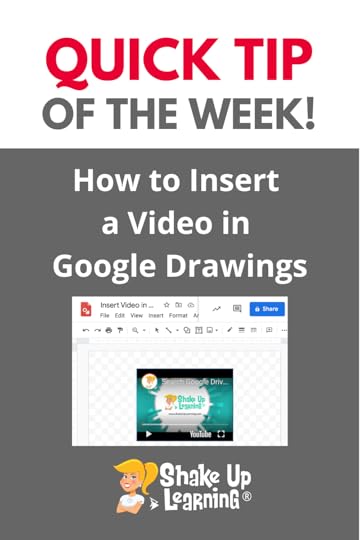 So…you don’t actually have the option to insert videos from the menu in Google Drawings, but here’s a super easy workaround!
So…you don’t actually have the option to insert videos from the menu in Google Drawings, but here’s a super easy workaround!
Thank you to Tony Vincent for sharing this trick!
Google Drawings is a very robust tool once you get familiar with it.
But many teachers have been asking if there is a way to insert a video since it’s not in the insert menu.
Try copying and pasting the video from Google Slides.
Watch this quick tutorial to learn how!
How to Insert a Video in #GoogleDrawings
Click To Tweet How to Insert a Video in Google DrawingsRelated: 20 Ways to Use Google Drawings in the ClassroomAccess ALL the Google Quick Tips Here!amzn_assoc_tracking_id = "shauplea-20";amzn_assoc_ad_mode = "manual";amzn_assoc_ad_type = "smart";amzn_assoc_marketplace = "amazon";amzn_assoc_region = "US";amzn_assoc_design = "enhanced_links";amzn_assoc_asins = "1735601829";amzn_assoc_placement = "adunit";amzn_assoc_linkid = "45e28ed74bb20171862e30ab5be2b0c3";
amzn_assoc_tracking_id = "shauplea-20";amzn_assoc_ad_mode = "manual";amzn_assoc_ad_type = "smart";amzn_assoc_marketplace = "amazon";amzn_assoc_region = "US";amzn_assoc_design = "enhanced_links";amzn_assoc_asins = "1735601802";amzn_assoc_placement = "adunit";amzn_assoc_linkid = "4c02c8cc44526bc9fbb710edf527215a";
© Shake Up Learning 2021. Unauthorized use and/or duplication of this material without express and written permission from this blog’s author and/or owner is strictly prohibited. Excerpts and links may be used, provided that full and clear credit is given to Kasey Bell and Shake Up Learning with appropriate and specific direction to the original content on ShakeUpLearning.com. See: Copyright Policy.
The post How to Insert a Video in Google Drawings appeared first on Shake Up Learning.





